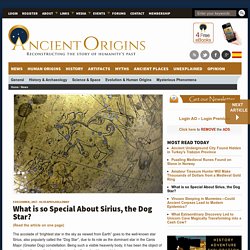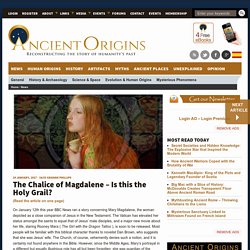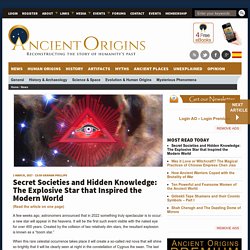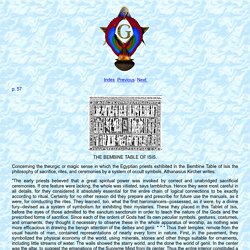

What is so Special About Sirius, the Dog Star? The accolade of ‘brightest star in the sky as viewed from Earth” goes to the well-known star Sirius, also popularly called the “Dog Star”, due to its role as the dominant star in the Canis Major (Greater Dog) constellation.

Being such a visible heavenly body, it has been the object of wonder and veneration to ancient peoples throughout human history. The Dog Star of Earth Interestingly, totally separate ancient cultures with no apparent communication have related the brlliant Sirius with either a wolf or a dog. Ark of the Covenant: Destruction, War & Plague – Part II. The Chalice of Magdalene – Is this the Holy Grail? On January 12th this year BBC News ran a story concerning Mary Magdalene, the woman depicted as a close companion of Jesus in the New Testament.

The Vatican has elevated her status amongst the saints to equal that of Jesus’ male disciples, and a major new movie about her life, staring Rooney Mara ( The Girl with the Dragon Tattoo ), is soon to be released. Most people will be familiar with this biblical character thanks to novelist Dan Brown, who suggests that she was Jesus’ wife. Secret Societies and Hidden Knowledge: The Explosive Star that Inspired the Modern World. A few weeks ago, astronomers announced that in 2022 something truly spectacular is to occur: a new star will appear in the heavens.

It will be the first such event visible with the naked eye for over 400 years. Created by the collision of two relatively dim stars, the resultant explosion is known as a “boom star.” When this rare celestial occurrence takes place it will create a so-called red nova that will shine so brightly that it will be clearly seen at night in the constellation of Cygnus the swan. The last time a “new star” became visible without the aid of modern telescopes was in 1604, although this one was caused by a supernova, an exploding far-away sun that remained visible for many months.
That one occurred in the constellation of Ophiuchus, the serpent-bearer, and its remnants can still been seen as a beautiful ring nebula by astronomers today. The New Star - Supernova 1604, also known as Kepler's Supernova. The Bembine Table of Isis. Index Previous Next p. 57 THE BEMBINE TABLE OF ISIS.

Concerning the theurgic or magic sense in which the Egyptian priests exhibited in the Bembine Table of Isis the philosophy of sacrifice, rites, and ceremonies by a system of occult symbols, Athanasius Kircher writes: "The early priests believed that a great spiritual power was invoked by correct and unabridged sacrificial ceremonies. If one feature were lacking, the whole was vitiated, says Iamblichus. Hence they were most careful in all details, for they considered it absolutely essential for the entire chain of logical connections to be exactly according to ritual. Certainly for no other reason did they prepare and prescribe for future use the manuals, as it were, for conducting the rites.
They learned, too, what the first hieromancers--possessed, as it were, by a divine fury--devised as a system of symbolism for exhibiting their mysteries. WESTCOTT'S KEY TO THE BEMBINE TABLE. History of the Swastika. The swastika has a lengthy history and enduring power, predominantly as a symbol of hate.

It was used at least 5,000 years before Adolf Hitler designed the Nazi flag. The word swastika comes from the Sanskrit svastika, which means “good fortune” or “well-being. " The motif (a hooked cross) appears to have first been used in Neolithic Eurasia, perhaps representing the movement of the sun through the sky.
To this day it is a sacred symbol in Hinduism, Buddhism, and Jainism. It is a common sight on temples or houses in India and Indonesia. The symbol experienced a resurgence in the late nineteenth century, following extensive archaeological work such as that of the famous German archaeologist Heinrich Schliemann. However, the work of Schliemann soon was taken up by movements that wanted to evoke racial purity, “Aryan identity” and German nationalist pride. The Human Body in Symbolism. THE BLACK STONE AT MECCA.
Topic: Symbolism in portraits of Elizabeth I. First glimpse of lost library of Elizabethan polymath John Dee. Where to start with the legend and life of Dr Dee?

Born on 13 July 1527, John Dee became one of the greatest scholars of the age, and a philosopher and courtier to Queen Elizabeth I. A polymath, he was a proto-modern scientist, a friend of Tycho Brahe, with interests in rational thought, as well as magic. He was a skilled astronomer but also an astrologer; a mathematician but also an alchemist. He put a hex on the Spanish armada, which is supposedly what caused the bad weather and the English victory. Shakespeare is said to have based both King Lear and Prospero on him. Advertisement During his lifetime, Dee accumulated dozens of artefacts and books and his house in Mortlake, London, became one of the largest libraries in England. Dee was interested in cryptography and has been linked with the mysterious Voynich manuscript. This is a wonderful pop-up book of mathematics. Wonders of Antiquity - The Delphian Tripod.
The Human Body in Symbolism - The Secret Teachings of All Ages.